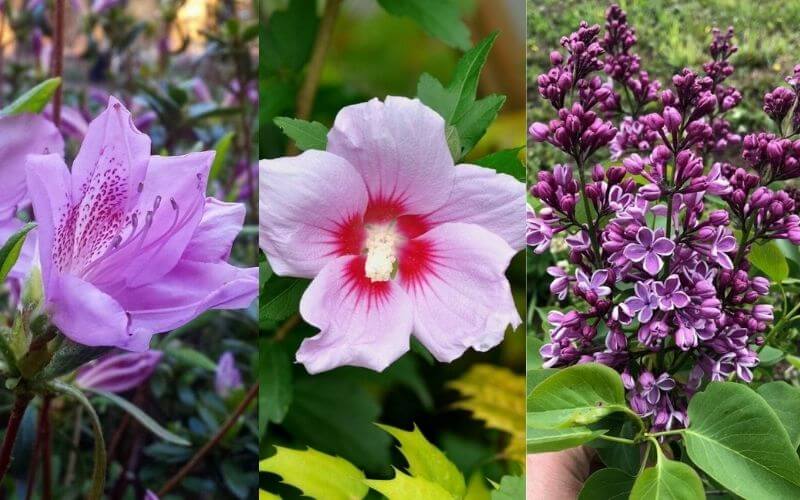
Purple flowering shrubs, the epitome of regality and luxury, have been adored by gardeners for centuries. If you share a fondness for purple blooms, looking to add a touch of nobility to your landscape or want to bask in the glory of these stunning blooms, there’s no denying the allure of purple flowering shrubs.
From the fragrant lilacs, which bloom in early spring, to the showstopping Weigela, which dazzles in shades of pink, red, and purple, there’s a deciduous or evergreen blooming bush with purple flowers for every taste and every season.
Whether you’re looking to create a focal point, a hedge, or add depth to the color spectrum of your garden, bushes that bloom range from the lightest lilac, rich violet, and a subtle mauve to a mysterious plum is a perfect choice. Their size varies as much as their hues, making it easy to find the perfect plant for any space, whether you have a large yard or a small patio.
And yes, if you’ve limited space, dwarf varieties are an excellent option for container gardens, patios, decks, and entranceways.
Read on to learn about some of our favorite purple flowering shrubs and bushes, along with pictures, hardiness zones, bloom time, and landscaping ideas for how and where to plant them.
14 Stunning Purple-Flowering Shrubs to Add to Your Landscape
From evergreen to deciduous options, and suitable for a variety of hardiness zones, here are the 14 most beautiful blooming shrubs with purple flowers to add a pop of color to your landscape.
1. Hibiscus syriacus (rose of Sharon)
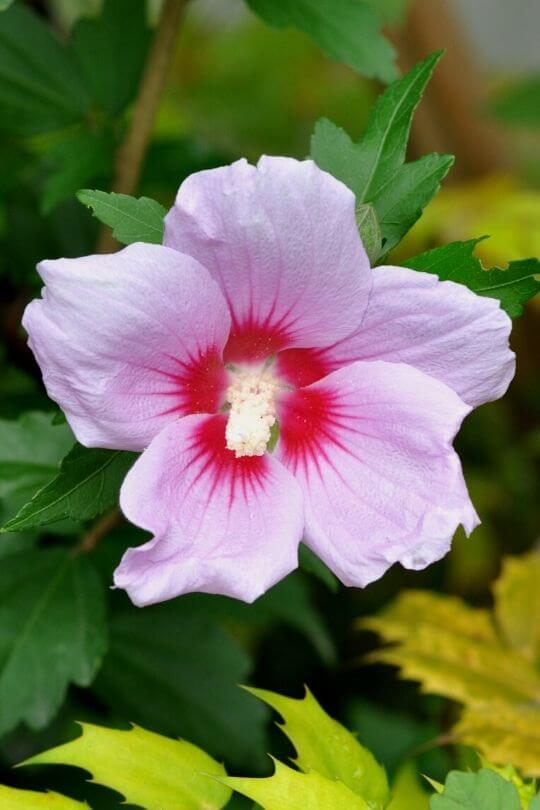
The Rose of Sharon is a deciduous shrub that boasts a vase-like shape, reaching a maximum height of 12 feet. It features a variation in flower color, with some blooms appearing white, others pink, and many a rich purple.
Regardless of color, these flowers typically have five evenly spaced petals and a very prominent stamen structure in the middle. These flowers are characterized by their evenly spaced petals and a prominent stamen structure in the center.
The blooming period for the Rose of Sharon is typically late in the season, with flowers opening in August but sometimes appearing as early as June and persisting for a few months into late September or early October.
The shrub leaves are also unique, with a three-lobed shape and form reminiscent of a maple leaf. They are green in the summer, sometimes turning yellow in the fall, but they rarely display an impressive fall color. The Rose of Sharon is often used as a border massing or as a warm-weather privacy screen due to its size, shape, and foliage density.
2. Weigela florida ‘Verweig’ MY MONET (weigela)
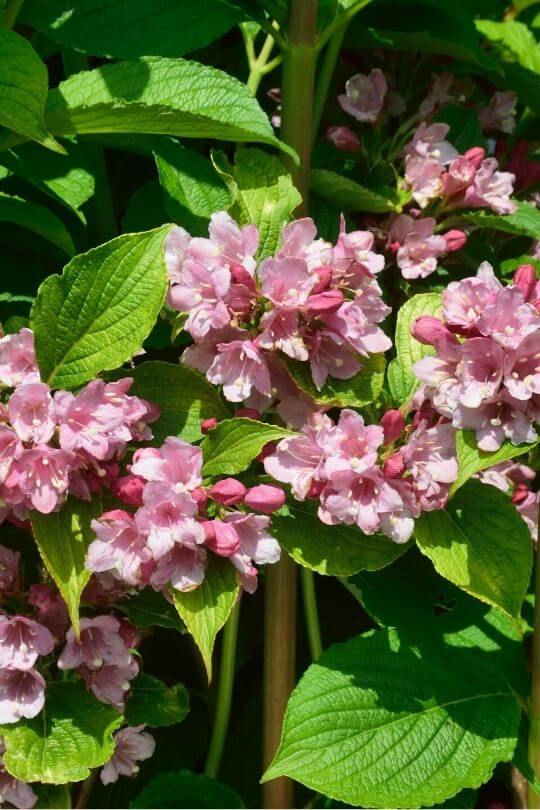
There are a few different weigela varieties. The ‘Verwig’ type, also known as MY MONET, is a small compact shrub.
This weigela species needs full sun and grows in soil ranging from slightly acidic to slightly alkaline.
The flowers of these shrubs are purple. They have a funnel shape and they can emerge on this year’s or last year’s growth. These flowers often have a lighter hue on the inside of the funnel.
The leaves offer their own distinct coloration. This foliage is deciduous and two-toned. This variegation features green splotches surrounded by whitish-pink on the outer edges of each leaf.
The combination of flower and leaf color makes this a very appealing shrub for those hoping to add color to their garden. To add to this intrigue, the flowers can sometimes attract hummingbirds.
3. Syringa vulgaris (lilac)
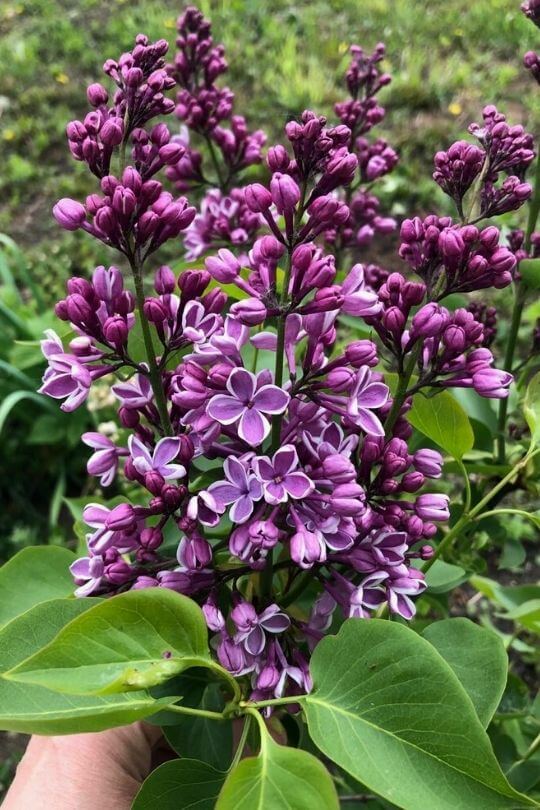
Lilac shrubs are very well known for their flowers. These flowers have a familiar scent to many people. They are also typically white, purple, or a confirmation of both.
In ideal conditions, these flowers emerge in numerous panicles. Each panicle can be about 8” long. Unfortunately, these blooms can be inconsistent.
Some lilacs will go years without flowering at all. But when they do flower, lilacs are a beautiful purple addition to the garden. To promote future blooms, cut off the flowers as soon as they begin to die back.
Although lilac is native to Europe, it has been growing in North America for multiple centuries. This is because colonists from Europe brought these shrubs with them during their earlies explorations of North America.
The leaves of lilac shrubs are heart-shaped. They have a smooth surface and a dark green color.
Beyond the flowers, lilacs do not have many other notable characteristics. They are also prone to developing powdery mildew.
But while this diminished the appearance of this shrub, the mildew does not often cause any detrimental damage to the plant.
Lilacs are not ideal for those looking for year-round interest. But they remain a great option for those who love purple flowers. Just make sure that you give you lilac the ideal growing conditions and care to encourage as many blooms as possible.
4. Magnolia ‘Ann’ (magnolia)
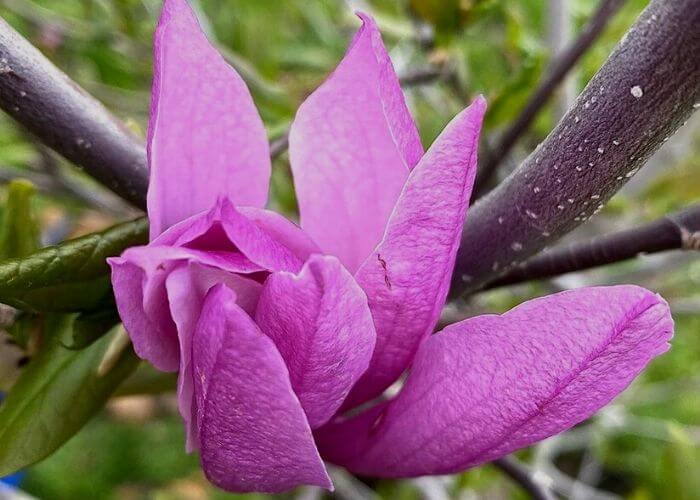
Ann magnolia can grow as a large shrub or as a small tree. Like most magnolias, this species features tremendous blooms.
The flowers are deep purple and have a shape similar to a tulip. These flowers bloom early in the season before the leaves appear. They are rather large and grow in high quantities across the entirety of the plant.
Although magnolias have grown in the wild for many decades, Ann magnolia is relatively new. This hybrid first appeared in the 1950s as a part of a larger group of hybrids developed at the National Arboretum. Including hybrids called ‘Betty,’ ‘Jane,’ and ‘Susan,’ this group is aptly named the Little Girl Series.
All the hybrids in this group result from a cross between Magnolia liliiflora ‘Nigra’ and Magnolia stellata ‘Rosea.’
The goal of this cross-breeding was to produce magnolias with many flowers that bloom later to avoid frost damage common in other magnolia varieties. Most of the Little Girl magnolias are large upright deciduous shrubs.
So long as you make an effort to maintain soil moisture and protection from strong winds, Ann magnolia will perform well.
The large, slightly fragrant, flowers are highly popular among gardeners. So, don’t miss your chance to add some iconic magnolia flowers to your yard.
5. Rhododendron ‘P.J.M.’ (rhododendron)
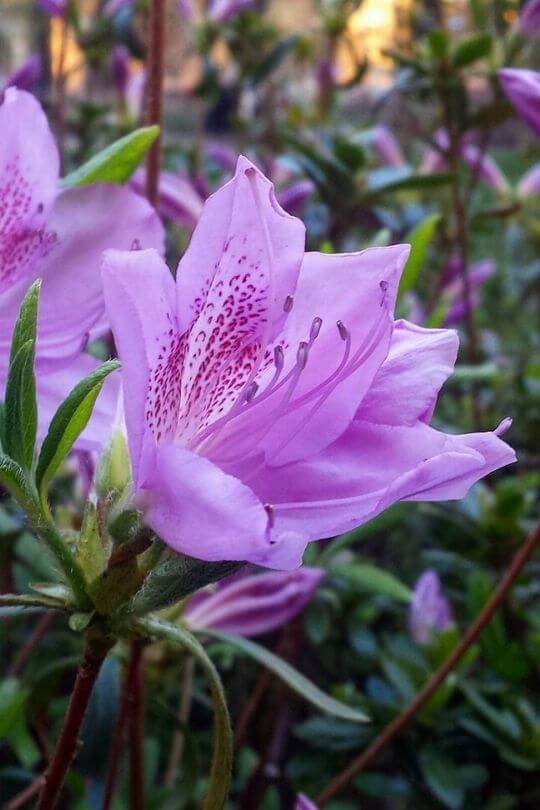
There are countless species within the Rhododendron genus. Currently, one of the most popular and commercially available varieties is a hybrid known as the ‘P.J.M.’ rhododendron. This hybrid first emerged from cultivation in Hopkinton, MA in the 1940s
This medium-sized shrub is a broadleaf evergreen. In spring it has vibrant purple flowers.
These flowers are typically quite numerous and noticeable from near and far. They bloom in clusters containing 4-9 flowers each.
‘P.J.M.’ rhododendron does not produce seeds, so it is an easy shrub to contain in your garden. It is also quite winter hardy making it a reliable shrub for colder climates.
The leaves of ‘P.J.M.’ rhododendron are only about 1-2” in total length. They are an oblong shape and evergreen.
Desperate remaining on the scrub through the winter this foliage does shows some change in coloration. In winter, the leaves can turn from green to a plum color.
While the changing leaf color is not an indication of a problem with the plant, there are many ailments common to rhododendrons.
These include root rot, leaf spots, and mildew. In addition to these issues, rhododendrons are also susceptible to insects like aphids, borers, and mites.
But these challenges do not take away from the attractiveness of this shrub. In my experience, ‘P.J.M.’ rhododendron is one of the most consistent springtime blooming shrubs.
Keep an eye out for the common problems mentioned above. But don’t let them discourage you from planting ‘P.J.M.’ rhododendron.
With a little bit of vigilance, you should be able to minimize these problems and enjoy the profuse purple flowers that ‘P.J.M.’ rhododendron offers every year.
6. Rhododendron ‘Conlee’ AUTUMN AMETHYST (evergreen azalea)
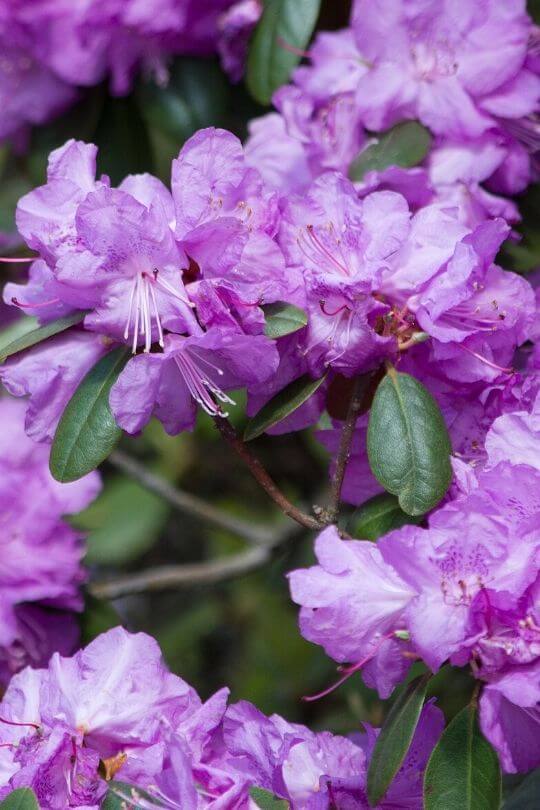
Azaleas and rhododendrons are extremely similar. They are even part of the same genus. To learn how to tell the difference between these shrubs, take a look at the previously published azalea article on this site.
One of the many similarities between rhododendron and azalea is that they both have varieties with copious amounts of purple flowers.
One of the best purple flowering azaleas is a hybrid called ‘Conlee’ AUTUMN AMETHYST.
This azalea is a rounded evergreen shrub. It can grow as a multi-stemmed plant and often reaches 6’ in height and spread.
Its flowers have a funnel shape and bloom in clusters. The color is a striking lavender to purple color.
This coloration includes reddish spots on the interior part of the petals. Overall, each flower is about 2” in length.
This species has some similar disease and insect problems as rhododendrons. It can also have a problem with frost killing off some of the flower buds.
If you live in a cold region this may be the reason your azalea is not flowering to the extent it could.
But again the flowers on this shrub are so valuable that they are worth the extra effort needed to care for them.
7. Spiraea japonica (spirea)
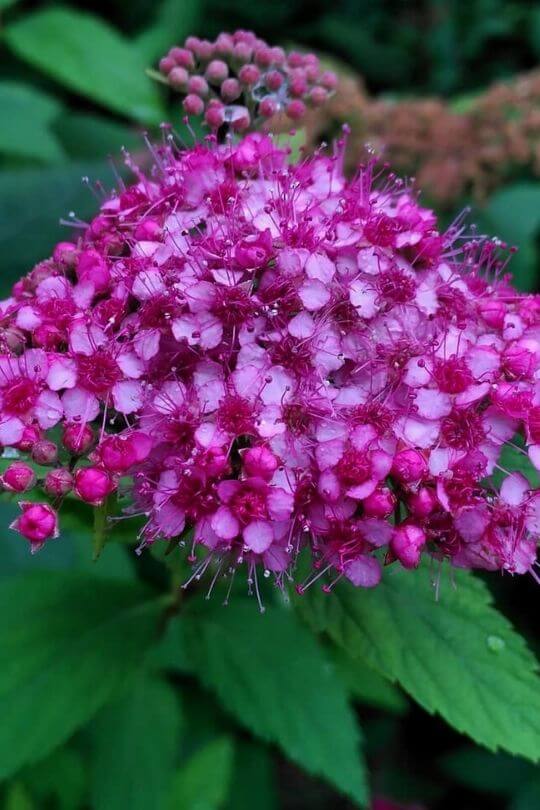
Although spirea can grow to 6’ tall, it is usually smaller than that at maturity. In general, it is a rounded shrub with the spread often exceeding the height.
Because of how popular this shrub is, there is an ever-growing number of cultivars. Many of these varieties will have the purple flowers you are looking for.
Often, these flowers have a reddish-purple color. They are also tiny but coalesce to form a cluster this is a few inches across with a flat shape. These flowers can attract butterflies as well.
The flowers of spirea bloom in lt spring to summer. In some cases, hey can rebloom later in the season.
To promote this, remove the first round of flowers after they fade. This is somewhat easy to do as spirea can tolerate shearing rather than focused running.
The leaves of spirea are deciduous with a sharp shape. The overall form of this shrub can vary based on growing conditions.
Although it is native to Japan, spirea is very common in American landscapes. Its widespread plantings and cultivars prove this is a shrub worth having.
8. Buddleja ‘Purple Haze’ (purple haze butterfly bush)
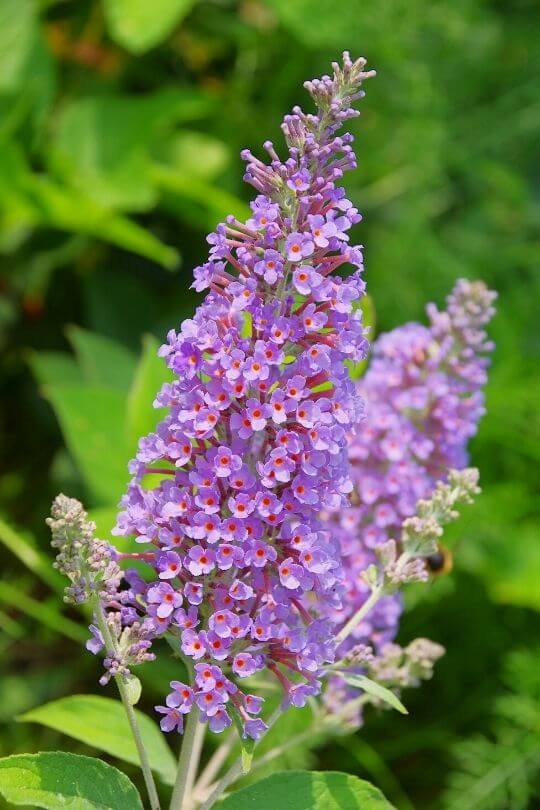
Be aware that many butterfly bushes are invasive throughout the United States. To learn about this species in-depth, look at the butterfly bush article on this site.
While invasive, most people can’t help but have a liking for the butterfly bush’s flowers. These flowers come in many colors. They are attractive to both humans and many pollinators.
Luckily, in response to the invasive characteristics and the popularity of these shrubs, botanists have worked to develop some sterile varieties.
These varieties have all the appealing qualities of butterfly bushes, but they are not able to reproduce. This eliminates the undesirable invasive qualities.
One of these sterile varieties is called purple haze butterfly bush. I’m sure you can guess the reason for this name.
This butterfly bush puts forth astounding purple flowers that grow in drooping spires.
If you love butterfly bushes but you don’t want to harm the environment, always select a sterile cultivar.
If your specific preference is for purple flowers, the purple haze butterfly bush is the variety for you.
9. Duranta erecta (golden dewdrops)
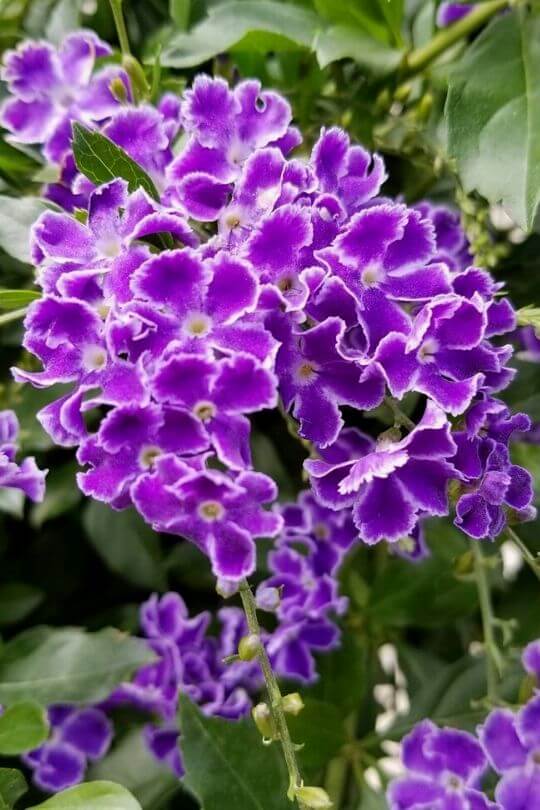
Golden dewdrops is a misnomer because no prominent part of this plant is golden.
For instance, the flowers on this plant are usually blue to violet. They grow in large clusters that hang down from the branches.
This broadleaf evergreen is suitable for gardens in warmer climates. This is because it is native to tropical regions in North and South America. When grown in the united states, it will only survive in zones 8 or warmer.
One interesting fact about this shrub is that its mature size can vary greatly. In its native tropical range, it can grow to be over 15’. In the colder parts of its range, it only reaches about 4’ at most.
Regardless of size, the flowers remain visually appealing with strong bursts of rich color. The leaves can show some variations as well.
At times they are simply green. Alternatively, they can have variegation with both green and white showing on each leaf.
In colder regions, golden dewdrops can be grown indoors as a container plant. This is partially because of its small size in those zones and partially because it will not likely survive the winter outdoors.
If you want a purple flowering shrub that is a bit more unique, look for golden dewdrops. But remember that it is meant for warmer climates and likely will need some special treatment north of zone 8.
10. Hydrangea macrophylla ‘Royal Purple’ (royal purple hydrangea)
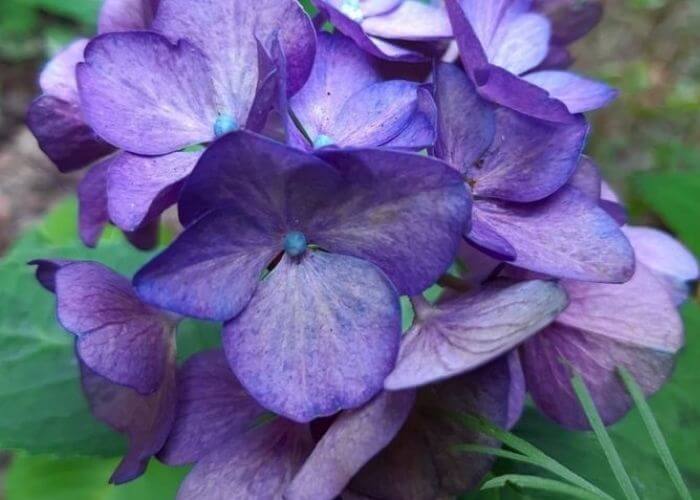
There are many cultivars of Hydrangea macrophylla These varieties include many different flower colors including purple. Perhaps the deepest purple belongs to royal purple hydrangea.
Like many hydrangeas, royal purple hydrangea has large flower heads that stay in bloom for the majority of the growing season. The hue if royal purple hydrangea is known to be exceptionally dark.
Overall this is a medium-sized rounded deciduous shrub. The leaves are rounded and large. They are also green with limited fall colors.
Hydrangea is a very popular plant in many settings and has a variety of uses in the garden.
Sometimes, the ph level in the soil can cause the flower color to change. But royal purple hydrangea usually has a consistently purple color.
This is not the hardiest oh hydrangea varieties as it only survives as far north as zone 6.
However, if you like purple flowers and you live in the southern regions of the United States, the royal purple hydrangea is a great choice for you.
11. Rosa rugosa ‘Purple Pavement’ (purple pavement rose)
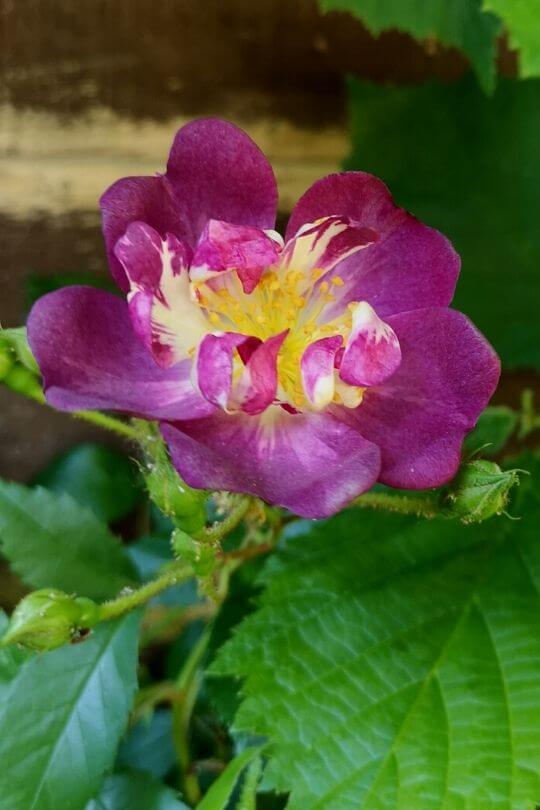
Purple pavement rose is a medium-sized deciduous shrub with large flowers. These flowers are about 2” across and they typically persist for the majority of the summer.
There are other varieties of Rugosa roses, but this one has the best blooms for those who want a purple color. After the flowers die back, a fruit known as a rose hip replaces them. This fruit looks like a small red tomato.
The leaves of purple pavement rose are small and rounded. They feature deep venation and a rugged texture.
Roses in the Rugosa genus often grow on sand dunes by beaches. In some states, they are considered invasive. So, check with your local authorities before planting one in your yard.
12. Abelia ‘Edward Goucher’ (abelia)
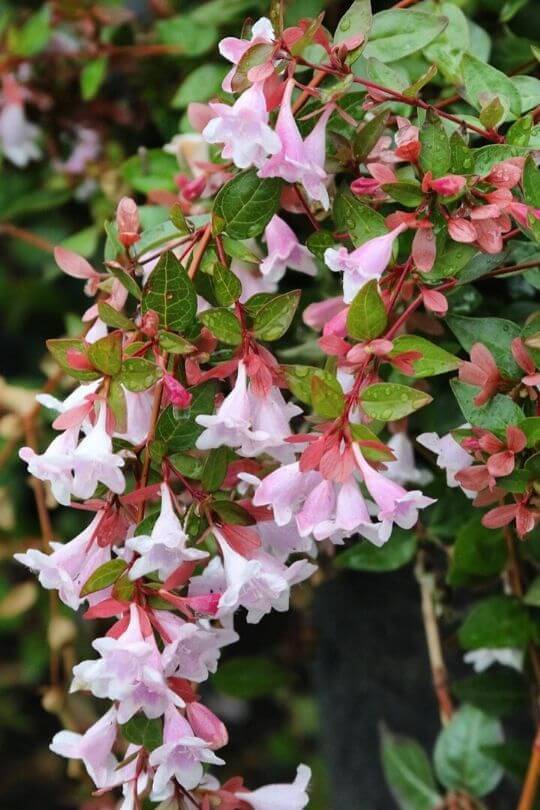
In total there are about 30 different varieties of abelia shrubs. These shrubs have a variety of different colors.
So, if you are looking for purple flowers, be careful in picking the correct variety.
‘Edward Goucher’ abelia is one of the best options for purple flowers. These flowers are small and bell-shaped with a light purple to lavender color. They bloom in the spring and last throughout the growing season.
Overall, abelia is a relatively small shrub requiring minimal maintenance. In colder climates, this shrub may die back to the ground in winter.
But this is not necessarily an indication that the plant has died. Often it will return in spring with its showy flowers on display.
Abelia is native to both Asia and Mexico. However, it is not classified as an invasive species in the United States.
If you are looking for a small purple shrub that is easy to care for, abelia is a quality option.
13. Calluna vulgaris (Scotch heather)
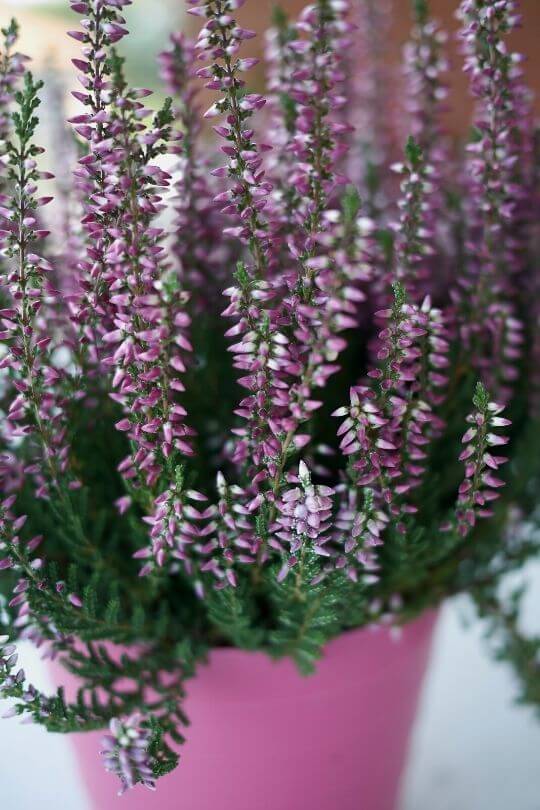
Scotch heather is a low growing evergreen shrub native to western Europe. It has naturalized in parts of North America. But many parts of the United States treat this plant as an invasive.
This status is due to Scotch heather’s tendency to spread vigorously. In ideal growing conditions, it will cover the ground in a dense mat. If you choose to plant Scotch heath, you need to make a constant effort to contain it.
On the plus side, the flowers are very impressive. While they are small, they cover almost the entirety of the plant. When in bloom, Scotch heath appears as a broad consistent swath of purple.
14. Lagerstroemia indica x fauriei ‘Chickasaw’ (Chickasaw crape myrtle)
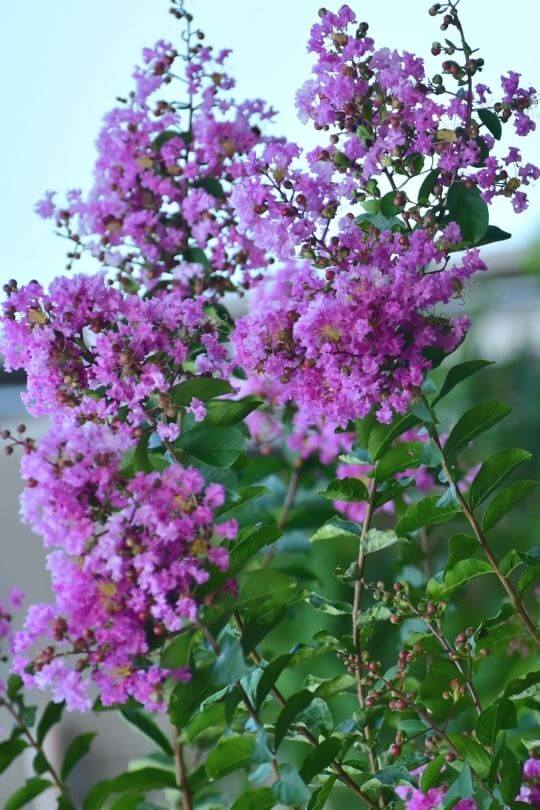
Chickasaw crape myrtle is a dwarf variety of the crape myrtle tree. This cross-breed species is a small, rounded shrub that reaches a maximum size of 2’.
When in bloom, panicles of lavender flowers appear across the majority of the shrub. Often, the flowers will last until the first frost.
Chickasaw crape myrtle prefers acidic soil and full sun. It also has a stronger resistance to disease compared to other crape myrtle varieties.
The foliage of this plant is also noteworthy. In fall it turns to an orange-red color before falling to the ground.
But the seasonal interest does not end there. As the flowers and foliage die back, the bark becomes visible. This bark exfoliates with peeling papery layers.
With beautiful purple and year-round appeal, Chickasaw crape myrtle will be a great addition to your garden.
Conclusion
Purple flowers are sure to catch your eye as you walk through a garden. Next time you want to plant a shrub in your yard, don’t forget about adding some color as well.
If you want a woody plant with great seasonal appeal, a purple flowering shrub is exactly what you should look for.

Written By
John Haryasz
John Haryasz is a writer with a background in landscape architecture. His education includes a Bachelor of Science in landscape architecture from UMass, Amherst with a minor in psychology. Following graduation, John worked in a small landscape architecture office. In this role, he led many successful projects in Berkshire County, MA. After a few years, John began offering freelance design services. He has since produced designs for projects across the country. As a writer, John aims to share knowledge while promoting engagement with the outdoor world.
